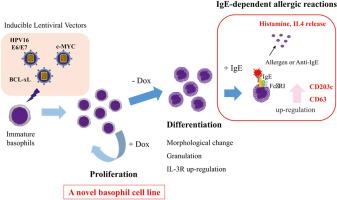Establishment of a novel human basophil cell line for functional analysis and in vitro allergy testing
IF 6.7
2区 医学
Q1 ALLERGY
引用次数: 0
Abstract
Background
Basophils are the rarest granulocytes and play diverse roles, e.g., in protective immunity and allergic inflammatory reactions. However, the underlying molecules and mechanisms involved in basophil differentiation and functions, particularly in humans, remain largely unknown. This may be due to the lack of high-quality research tools.
Methods
We established a novel, immortalized, human basophil cell line by introducing human papillomavirus 16-E6/E7, c-MYC, and BCL-xL gene expression systems into cultured basophils, and evaluated whether this cell line is useful as a research tool, compared with KU812, which is the most commonly-used human basophil cell line.
Results
This cell line expressed various basophil markers, including CD123, CD203c, and the high-affinity immunoglobulin (Ig)E receptor α-chain and can mature into more differentiated cells under specific culture conditions. The differentiated cells stimulated with anti-IgE antibodies showed increased CD203c expression in a dose-dependent manner, whereas the differentiated KU812 cells showed little activation after the stimulation.
The established cell line also demonstrated increased sensitivity to allergic activation when stimulated with an allergen (NP-BSA) and allergen-specific IgE (anti-NP-IgE). Furthermore, histamine- and interleukin-4-releasing abilities were also confirmed. These allergic activation profiles were similar to those of basophils from healthy individuals, although the activation levels of the established cells were lower than those of basophils from highly-sensitive individuals.
Conclusions
These findings suggest that the established basophil cell line has substantially different characteristics from a conventional cell line and could serve as a new tool for investigating basophil differentiation and functions, as well as for testing allergic reactions.

一种用于功能分析和体外过敏试验的新型人嗜碱性细胞系的建立。
背景:嗜碱性粒细胞是最罕见的粒细胞,在保护性免疫和过敏性炎症反应中发挥着多种作用。然而,涉及嗜碱性粒细胞分化和功能的潜在分子和机制,特别是在人类中,仍然很大程度上未知。这可能是由于缺乏高质量的研究工具。方法:将人乳头瘤病毒16-E6/E7、c-MYC和BCL-xL基因表达系统导入培养的嗜碱性细胞中,建立一种新的永生化人嗜碱性细胞系,并与最常用的人嗜碱性细胞系KU812进行比较,评估该细胞系是否可作为研究工具。结果:该细胞系表达CD123、CD203c及高亲和性免疫球蛋白E受体α-链等多种嗜碱性细胞标志物,在特定培养条件下可成熟为分化程度较高的细胞。经抗ige抗体刺激的分化细胞CD203c表达呈剂量依赖性增加,而KU812细胞在刺激后几乎没有活化。当用过敏原(NP-BSA)和过敏原特异性IgE(抗np -IgE)刺激时,所建立的细胞系也显示出对过敏激活的敏感性增加。此外,组胺和白细胞介素-4的释放能力也得到证实。这些过敏激活谱与来自健康个体的嗜碱性细胞相似,尽管建立的细胞的激活水平低于来自高度敏感个体的嗜碱性细胞。结论:这些发现表明,所建立的嗜碱性粒细胞细胞系具有与常规细胞系截然不同的特征,可以作为研究嗜碱性粒细胞分化和功能以及检测过敏反应的新工具。
本文章由计算机程序翻译,如有差异,请以英文原文为准。
求助全文
约1分钟内获得全文
求助全文
来源期刊

Allergology International
ALLERGY-IMMUNOLOGY
CiteScore
12.60
自引率
5.90%
发文量
96
审稿时长
29 weeks
期刊介绍:
Allergology International is the official journal of the Japanese Society of Allergology and publishes original papers dealing with the etiology, diagnosis and treatment of allergic and related diseases. Papers may include the study of methods of controlling allergic reactions, human and animal models of hypersensitivity and other aspects of basic and applied clinical allergy in its broadest sense.
The Journal aims to encourage the international exchange of results and encourages authors from all countries to submit papers in the following three categories: Original Articles, Review Articles, and Letters to the Editor.
 求助内容:
求助内容: 应助结果提醒方式:
应助结果提醒方式:


